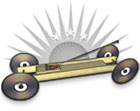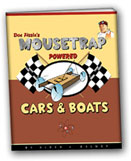Mousetrap Vehicles: Friction
Friction is a force that resists motion. Before you start building your own mousetrap powered racer learn all about friction and how it will effect your vehicle.
Perhaps the second most important concept to understand when building a mousetrap powered vehicle is the concept of friction. In the perfect universe where there was no friction a mousetrap vehicle would travel forever or until it hits something. But we do not live in a perfect universe and friction is a real force that acts against the motion of all moving objects. Friction occurs anytime two surfaces slip, slide, touch, and/or move against one another. There are two basic types of friction, surface friction, and fluid friction. Friction is a force that acts against the motion of all moving objects. Energy is always needed to overcome friction and the greater the amount of friction the less efficient the system. Two of the by product of friction are heat and sound, these are normally considered lost forms of energy because it is hard to recapture energy once it has been turned into heat and sound.
Surface Friction
Surface friction occurs any time two surfaces touch and/or rub against one another. The cause of surface friction is mutual contact of microscopic irregularities that exists on all surfaces. These microscopic irregularities act like little road blocks or obstructions to motion. Even surfaces that appear to be perfectly smooth have irregularities when viewed under a microscope. The amount of surface friction acting between two object depends on the kinds of material from which the two surfaces are made and how hard the two surfaces are pressed together. A wooden block placed on a sheet of glass will have an easier time sliding than when the same block is placed on a concrete sidewalk. If a mass is now placed on top of the wooden block there will be more weight or force pressing the block onto the other surface making it even more difficult for the block to slide. As any two surfaces are pressed harder and harder together their irregularities will require more and more force to overcome.

bonus tip: microscopic irregularities act like small mountains and valleys that cause objects to resist sliding.
ƒ = N × μ
formula: The force of friction [ƒ] depends on how slippery two surfaces are together called the coefficient of friction [μ] and how hard the surfaces are pressed together [N]. The coefficient is measured in newtons, the normal force in newtons, and the coefficient is newtons over newtons.
Decreaseing Friciton and Lubricants
Surface friction can be decreased by smoothing out the irregularities that exists between two surfaces and/or by adding a lubricant. The smoother two surfaces can be made the less friction that will exists between them, to a point. One might think that if you could make two surface perfectly smooth there would be no friction at all. But on a microscopic scale when any two surfaces become perfectly smooth there is the potential for bonding on an atomic level where molecules and atoms now interact with one another. So we can never totally eliminate surface friction but we can learn how to decrease it as much as possible by smoothing out two touching surfaces. Lubricants are an alternative method to reducing the coefficient of friction. There is a wide variety of lubricants and it is important to match-up the correct lubricant for each situation in order to achieve the results desired. Most lubricants act to smooth out two surfaces by fill the small gaps and imperfections that exists between in order to lower the coefficient of friction. But not all lubricants decrease the force of friction, some lubricants are very viscous and are used only to prevent the build-up of heat that would normally damage a material; these same heat preventing lubricants, in some cases, can increase the total force of friction so they are not for use in all applications.

bonus tip: two perfectly smooth surfaces that touch one another can bond on an atomic level.
Surface Friciton and Motion
It will always take more force to start an object sliding than to keep the object sliding once it is moving; this is because you first have to brake through the road blocks or irregularities of the two surfaces in order to start the motion. Once you brake through these irregularities, the inertia or the momentum of the moving object will continue to help it continue to brake through the irregularities as long as enough energy put back into the system to keep the block sliding. This concept also shows that surface friction is unaffected by speed. Surface friction is always the minimum force required to overcome the irregularities regardless of how fast the object is sliding.
Coefficient of Friction
The coefficent of friction is always dependent on the two materials that are touching. Brass may have one coefficient wen in contact with wood but a different coefficient when in contact with steel. From the table bellow you will see a common list of materials and their coefficient when combined together. The idea here is that the smaller the number the less friction two materials have when used together. Use this table as your guide to help pick the best materials to help reduce friction with your bushing system.
*Can't find what you're looking for? Ask Doc Fizzix »




